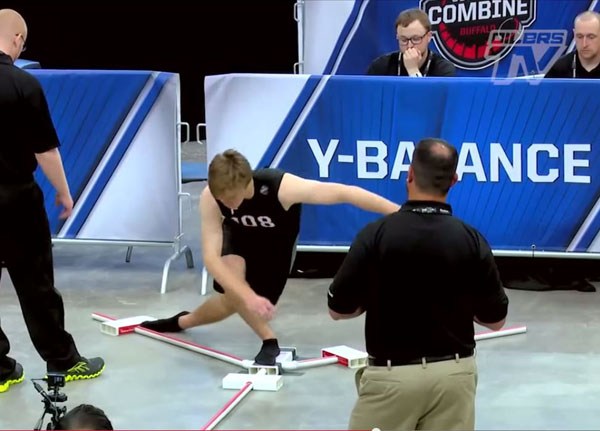The Y-Balance Test is a dynamic test performed in a single-leg stance that requires strength, flexibility, core control and proprioception. It has been used to assess physical performance, demonstrate functional symmetry and identify athletes at greater risk for lower extremity injury. The protocol described here is for the Lower Quarter version of the Y Balance test. There is also an Upper Quarter Y Balance Test which tests upper body balance and stability.
purpose: To assess active balance and core control
equipment required: Y-Balance Test Kit, tape measure.
pre-test: Explain the test procedures to the subject. Perform screening of health risks and obtain informed consent. Prepare forms and record basic information such as age, height, body weight, gender, test conditions. Measure the limb length (right side) which is needed for the results calculations. Perform an appropriate warm-up. See more details of pre-test procedures.
protocol: The goal of this test is to maintain single-leg balance on one leg while reaching as far as possible with the contralateral leg in three different directions. The three movement directions are anterior, posteromedial and posterolateral, performed on each leg. Therefore there are six tests to be performed, in the following order:
- Right Anterior Reach
- Left Anterior Reach
- Right Posteromedial Reach
- Left Posteromedial Reach
- Right Posterolateral Reach
- Left Posterolateral Reach
 Conner McDavid doing the Y-Balance test at the 2015 NHL Combine.
Conner McDavid doing the Y-Balance test at the 2015 NHL Combine.procedure: The starting position is standing on one leg at the stance plate with the toes of the foot at the red line, and the other leg touching down lightly just behind the plate. The non-stance foot is reached out in the desired direction, pushing the reach indicator as far as they can while maintaining balance. The free foot must be returned to the starting position under control. The subject may not touch down the free leg during the movement to keep balance, or put their foot on top of the reach indicator to gain support, and cannot kick out the indicator. For a detailed explanation, see this video.
Scoring: All measurements are taken from the red line on the stance plate, to the nearest 0.5 cm. The distance can be read from the test device. Each test is repeated three times, and the maximum reach in each direction is recorded. The results are calculated taking limb length into consideration, to determine a "composite reach distance". Asymmetry can also be assessed by comparing the results from each leg.
Comments: This test is was added to the test protocols for the NHL Combine in 2015. The Y Balance test is based on research done on the Star Excursion Balance Test.
References:
- Shaffer SW, Teyhen DS, Lorenson CL, Warren RL, Koreerat CM, Straseske CA, Childs JD. Y-Balance Test: a reliability study involving multiple raters. Mil Med. 2013;178(11):1264-70.
The Test in Action
- This test is part of the test protocols for the NHL Combine.
Similar Tests
- A similar test, the Star Excursion Balance Test
Related Pages
- See a video about the Y Balance test
- About the NHL Combine
- Other balance tests
- About balance testing


 Current Events
Current Events